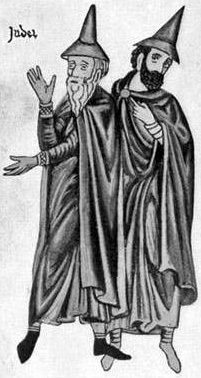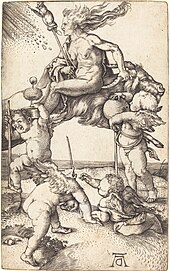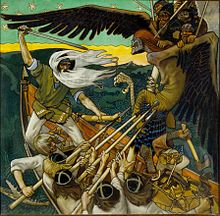Witch (archetype)
[2] Jean La Fontaine wrote that the "stereotype of evil appears not to have been closely connected to the actions of real people except when it was mobilised against the current enemies of the Church.
"[3] The origins of the witch archetype have been connected to antisemitic beliefs:[1][4] in 1215, the Fourth Council of the Lateran issued an edict that all Jews must wear identifying headgear, a pointed cap known as a Judenhat.
[6] According to Jung, The primordial image, or archetype, is a figure—be it a daemon, a human being, or a process—that constantly recurs in the course of history and appears wherever creative fantasy is freely expressed.
[7] Jung traces the term back to Philo, Irenaeus, and the Corpus Hermeticum, which associate archetypes with divinity and the creation of the world, and notes the close relationship of Platonic ideas.
Neumann gives the example of the witch in the fairytale of Hansel and Gretel whose house (which symbolises the external) is made of gingerbread, but who in reality (internally) "eats little children".
According to author Claire Douglas, Jung suggested that this might be due to "the unconscious power of the suppressed archaic feminine" which had been "rejected, unclaimed, and repressed".
For example, a person who identifies strongly with the witch archetype may struggle with feelings of being an outsider or having unconventional beliefs, resulting in social isolation or self-doubt.
The vilification of those who exhibit traits associated with the witch, such as independence, wisdom, and defiance of norms, can result in the suppression of individual expression and the perpetuation of social injustices.
[25] Medieval and early modern European depictions of witches were further inspired by texts such as Canon Episcopi, a demonology-centered work of literature, and Malleus Maleficarum, a "witch-craze" manual published in 1487, by Heinrich Kramer and Jacob Sprenger.
Many scholars attribute their manifestation in art as inspired by texts such as Canon Episcopi, a demonology-centered work of literature, and Malleus Maleficarum, a "witch-craze" manual published in 1487, by Heinrich Kramer and Jacob Sprenger.
[26] Canon Episcopi, a ninth-century text that explored the subject of demonology, initially introduced concepts that would continuously be associated with witches, such as their ability to fly or their believed fornication and sexual relations with the devil.
These characteristics were distinguished as Medusa-like or Lamia-like traits when seen in any artwork (Medusa's mental trickery was associated with Diana the Huntress's psychic powers and Lamia was a rumored female figure in the Medieval ages sometimes used in place of Herodias).
[29] Some scholars interpret this piece as utilizing the logic of the Canon Episcopi, in which women used their mental powers and bodily seduction to enslave and lead men onto a path of eternal damnation, differing from the unattractive depiction of witches that would follow in later Renaissance years.
These stereotypes were usually rooted in early Renaissance religious discourse, specifically the Christian belief that an "earthly alliance" had taken place between Satan's female minions who "conspired to destroy Christendom".
Meanwhile, their nudity while feasting is recognized as an allusion to their sexual appetite, and some scholars read the witch riding on the back of a goat-demon as representative of their "flight-inducing [powers]".
[27] The importance of such a heroine sheds light on the positive effects associated with magic and witchcraft, a change from the often brutalized and tortured illustrations found in early nineteenth century literature.
Other examples of heroic witches in fictional literature include Glinda from The Wonderful Wizard of Oz (1900), Serafina Pekkala from His Dark Materials (1995–2000), and Hermione Granger from the Harry Potter series.







